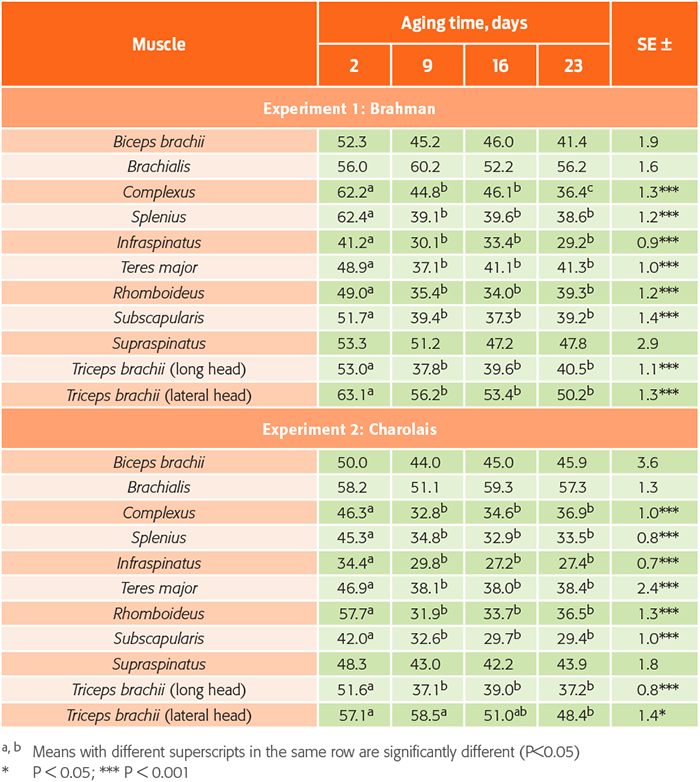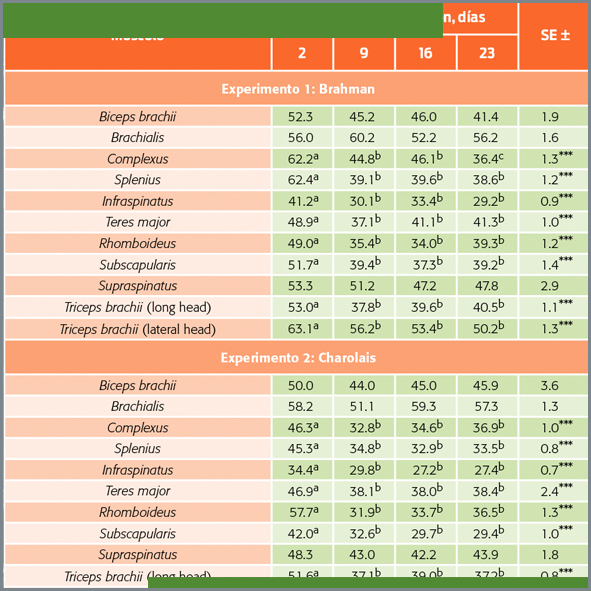Freezing, thawing and aging improves the tenderness of chuck muscles from young bulls of different phenotypes
Main Article Content
Abstract
Veterinaria México OA
ISSN: 2448-6760
Cite this as:
- Rubio-Lozano MS, Pérez-Buitrón EV, Méndez-Medina RD, Chávez-Gómez A, Delgado-Suárez EJ. Freezing, thawing and aging improves the tenderness of chuck muscles from young bulls of different phenotypes. Veterinaria México OA. 2014;1(1). doi: 10.21753/vmoa.1.1.333.
We evaluated eleven chuck muscles from phenotypically selected Brahman (BR, n =10) and Charolais (CH, n =10) young bull carcasses for the effect of freezing, thawing, and aging for 2, 9, 16, and 23 days on Warner-Bratzler shear force(WBSF) Splenius, infraspinatus, teres major, rhomboideus, and subscapularis from both phenotypes, and complexus from CH had tender (≤ 40 N) 9 d WBSF values. No further improvement in WBSF was observed beyond 9 days of aging. Overall, we observed freezing, thawing and aging of several chuck muscles from young bulls significantly improves beef tenderness. Further studies would help optimizing this tenderization strategy and assess its potential impact on other meat quality attributes.
Table 1. Least square means of WBSF (N) for Brahman and Charolais chuck muscles (n = 10) frozen for one week, thawed for 24-30 h at 2-4 °C, and aged for different periods

Article Details
References
AMSA. 1995. Research guidelines for cookery, sensory evaluation, and instrumental tenderness measurements of fresh meat. In: Chicago, IL: American Meat Science Association and National Livestock and Meat Board.
Belew, J.B., Brooks, J.C., McKenna, D.R., and Savell, J.W. 2003. Warner–Bratzler shear evaluations of 40 bovine muscles. Meat Science. 64(4): 507-512.
Bidner, T.D., Wyatt, W.E., Humes, P.E., Franke, D.E. and Blouin, D.C. 2002. Influence of Brahman-derivative breeds and Angus on carcass traits, physical composition, and palatability. Journal of Animal Science. 80: 2126-2133.
Bonilha, S.F.M., Tedeschi, L.O., Packer, I.U., Razook, A.G., Alleoni, G.F., Nardon, R.F. and Resende, F.D. 2008. Evaluation of carcass characteristics of Bos indicus and tropically adapted Bos taurus breeds selected for postweaning weight. Journal of Animal Science. 86(8): 1770-1780.
Bratcher, C.L., Johnson, D.D., Littell, R.C. and Gwartney, B.L. 2005. The effects of quality grade, aging, and location within muscle on Warner–Bratzler shear force in beef muscles of locomotion. Meat Science. 70(2): 279-284.
Camponova. 2006. Suministran anabólicos al 70 por ciento del ganado en México. 2000Agro Revista Industrial del Campo. Nov 9. Sección Agroindustria. http://www.2000agro.com.mx/agroindustria/suministran-anabolicos-a-70-por-ciento-del-ganado-en-mexico/.
Claus, H.L., Dikeman, M.E., Murray, L., Brooks, J.C., Shook, J., Hilton, G.G., Lawrence, T.E., Mehaffey, J.M., Johnson, B.J., Allen, D.M., Streeter, M.N., Nichols, W.T., Hutcheson, J.P., Yates, D.A., Miller, M.F., Hunt, M.C. and Killefer, J. 2010. Effects of supplementing feedlot steers and heifers with zilpaterol hydrochloride on Warner–Bratzler shear force interrelationships of steer and heifer longissimus lumborum and heifer triceps brachii and gluteus medius muscles aged for 7, 14 and 21d. Meat Science 85(2): 347-355.
Crouse, J.D. and Koohmaraie, M. 1990. Effect of freezing of beef on subsequent postmortem aging and shear force. Journal of Food Science. 55(2): 573-574.
Chávez, A., Pérez, E., Rubio, M.S., Méndez, R.D., Delgado, E.J. and Díaz, D. 2012. Chemical composition and cooking properties of beef forequarter muscles of Mexican cattle from different genotypes. Meat Science. 91(2): 160-164.
Grayson, A.L., King, D.A., Shackelford, S.D., Koohmaraie, M. and Wheeler, T.L. 2014. Freezing and thawing or freezing, thawing, and aging effects on beef tenderness. Journal of Animal Science. 92: 2735-2740.
Gruber, S.L., Tatum, J.D., Scanga, J.A., Chapman, P.L., Smith, G.C. and Belk, K.E. 2006. Effects of postmortem aging and USDA quality grade on Warner-Bratzler shear force values of seventeen individual beef muscles. Journal of Animal Science. 84(12): 3387-3396.
Hildrum, K.I., Rodbotten, R., Hoy, M., Berg, J., Narum, B. and Wold, J.P. 2009. Classification of different bovine muscles according to sensory characteristics and Warner Bratzler shear force. Meat Science. 83(2): 302-307.
King, D.A., Wheeler, T.L., Shackelford, S.D. and Koohmaraie, M. 2009. Comparison of palatability characteristics of beef gluteus medius and triceps brachii muscles. Journal of Animal Science. 87(1): 275-284.
Koohmaraie, M. 1990. Quantification of Ca2(+)-dependent protease activities by hydrophobic and ion-exchange chromatography. Journal of Animal Science. 68: 659-665.
Li, K., Zhang, Y., Mao, Y., Cornforth, D., Dong, P., Wang, R., Zhu, H. and Luo, X. 2012. Effect of very fast chilling and aging time on ultra-structure and meat quality characteristics of chinese yellow cattle M. Longissimus lumborum. Meat Sci. 92(4),: 795-804.
Mach, N., Bach, A., Realini, C.E., Font i Furnols, M., Velarde, A. and Devant, M. 2009. Burdizzo pre-pubertal castration effects on performance, behaviour, carcass characteristics, and meat quality of holstein bulls fed high-concentrate diets. Meat Science. 81(2): 329-334.
Mendez, R.D., Meza, C.O., Berruecos, J.M., Garces, P., Delgado, E.J. and Rubio, M.S. 2009. A survey of beef carcass quality and quantity attributes in Mexico. Journal of Animal Science. 87(11): 3782-3790.
Molina, M.E., Johnson, D.D., West, R.L. and Gwartney, B.L. 2005. Enhancing palatability traits in beef chuck muscles. Meat Science. 71(1): 52-61.
Nelson, J.L., Dolezal, H.G., Ray, F.K. and Morgan, J.B. 2004. Characterization of certified Angus beef steaks from the round, loin, and chuck. Journal of Animal Science. 82: 1437-1444.
Rhee, M. S., Wheeler, T.L., Shackelford, S.D. and Koohmaraie, M. 2004. Variation in palatability and biochemical traits within and among eleven beef muscles. Journal of Animal Science. 82: 534-550.
Rubio L.M.S., Méndez M.R.D. and Huerta-Leidenz, N. 2007. Characterization of beef semimembranosus and adductor muscles from US and Mexican origin. Meat Science. 76(3): 438-443.
Searls, G.A., Maddock, R.J. and Wulf, D.M. 2005. Intramuscular tenderness variation within four muscles of the beef chuck. Journal of Animal Science. 83: 2835-2842.
Shackelford, S.D., Wheeler, T.L. and Koohmaraie, M. 1995. Relationship between shear force and trained sensory panel tenderness ratings of 10 major muscles from Bos indicus and Bos taurus cattle. Journal of Animal Science. 73: 3333-3340.
Simões, J.A., Mendes, M.I. and Lemos, J.P.C. 2005. Selection of muscles as indicators of tenderness after seven days of ageing. Meat Science. 69(4): 617-620.
Stelzleni, A.M., Patten, L.E., Johnson, D.D., Calkins, C.R. and Gwartney, B.L. 2007. Benchmarking carcass characteristics and muscles from commercially identified beef and dairy cull cow carcasses for Warner-Bratzler shear force and sensory attributes. Journal of Animal Science. 85(10): 2631-2638.
Vieira, C., Diaz, M.T., Martinez, B. and Garcia-Cachan, M.D. 2009. Effect of frozen storage conditions (temperature and length of storage) on microbiological and sensory quality of rustic crossbred beef at different states of ageing. Meat Sci. 83(3): 398-404.
Von Seggern, D.D., Calkins, C.R., Johnson, D.D., Brickler, J.E. and Gwartney, B.L. 2005. Muscle profiling: Characterizing the muscles of the beef chuck and round. Meat Science. 71(1): 39-51.
Yadata, M.A., Werner, C., Tibbo, M., Wollny, C.B.A. and Wicke, M. 2009. Assessment of the sensory quality and shelf stability of selected Horro beef muscles in Ethiopia. Meat Science. 83(1): 113-119
License

Veterinaria México OA by Facultad de Medicina Veterinaria y Zootecnia - Universidad Nacional Autónoma de México is licensed under a Creative Commons Attribution 4.0 International Licence.
Based on a work at http://www.revistas.unam.mx
- All articles in Veterinaria México OA re published under the Creative Commons Attribution 4.0 Unported (CC-BY 4.0). With this license, authors retain copyright but allow any user to share, copy, distribute, transmit, adapt and make commercial use of the work, without needing to provide additional permission as long as appropriate attribution is made to the original author or source.
- By using this license, all Veterinaria México OAarticles meet or exceed all funder and institutional requirements for being considered Open Access.
- Authors cannot use copyrighted material within their article unless that material has also been made available under a similarly liberal license.



